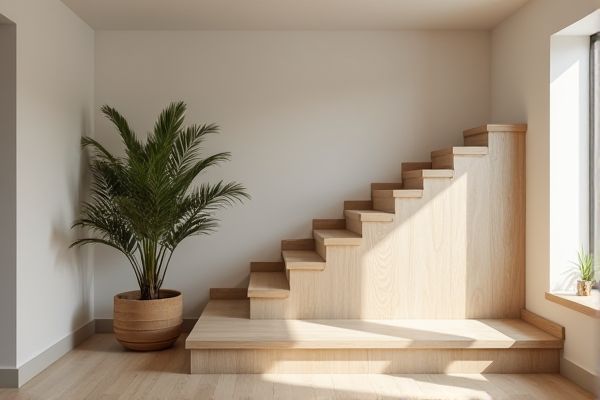
Box stairs feature open sides with visible stringers, offering a modern and spacious appearance, whereas housed stairs are enclosed within walls, providing a more traditional and compact design. Understanding the differences can help you choose the best staircase style for your home's functionality and aesthetic; read on to explore the key advantages of each type.
Table of Comparison
| Feature | Box Stairs | Housed Stairs |
|---|---|---|
| Design | Fully enclosed stringers forming a box shape | Treads and risers housed into grooves of stringers |
| Appearance | Simple, clean, and solid look | Elegant, seamless, and integrated finish |
| Structural Strength | Very strong due to box frame construction | Strong but relies on precise joinery for stability |
| Installation Complexity | Moderate; requires precise measurements | High; needs skilled joinery for housing joints |
| Cost | Generally lower to mid-range | Typically higher due to craftsmanship |
| Maintenance | Easy to clean and maintain | May need more care to preserve joints |
| Applications | Residential and commercial spaces | High-end residential and bespoke projects |
Introduction: Box Stairs vs Housed Stairs
Box stairs feature visible stringers and open sides, providing a modern and airy appearance ideal for contemporary homes. Housed stairs have stringers concealed within the wall structure, offering a seamless, integrated look that maximizes space efficiency and enhances durability. Your choice between box and housed stairs can significantly impact both the aesthetic and functional elements of your interior design.
Defining Box Stairs
Box stairs are a type of staircase where each tread is supported on all sides by enclosed stringers, creating a solid, box-like structure that enhances stability and safety. Unlike housed stairs, which have one or both stringers recessed to conceal the treads and risers, box stairs present a more robust and enclosed appearance. If you're considering staircase options, understanding how box stairs offer a distinct architectural style and structural integrity can help you make an informed choice for your project.
Understanding Housed Stairs
Housed stairs feature stringers recessed into the wall, providing a seamless and stable integration that enhances structural integrity and aesthetic appeal. Unlike box stairs, which are constructed with closed stringers forming a box-like frame, housed stairs are embedded within the wall framework, offering a cleaner finish and optimized space usage. Understanding housed stairs helps you choose a design that maximizes durability and elegant functionality in your architectural project.
Key Structural Differences
Box stairs feature a fully enclosed structure with stringers on both sides, providing strong lateral support and a compact design ideal for tight spaces. Housed stairs integrate the stringers into the surrounding walls, offering a cleaner, more streamlined appearance while relying on the wall for additional stability. Structural differences impact load distribution and installation complexity, with box stairs being more self-supporting and housed stairs requiring precise wall integration.
Installation Process Comparison
Box stairs feature a straightforward installation process involving assembling pre-cut treads and risers within a simple frame, allowing for quicker setup ideal for standard staircases. Housed stairs require precise fitting of stringers and wall boards, demanding skilled craftsmanship to embed the staircase securely within wall cavities, which extends installation time. Your choice impacts labor intensity and project duration, with box stairs offering a faster, more modular installation compared to the complex, integrated approach of housed stairs.
Material Options for Each Style
Box stairs typically feature solid timber or engineered wood, offering a variety of hardwoods like oak, maple, and cherry for durability and aesthetic appeal. Housed stairs often utilize a combination of materials, including timber for the treads and risers, with the stringers cleverly concealed within the walls, allowing for plaster or drywall finishes that blend seamlessly with the surrounding architecture. Both styles accommodate custom finish options such as stained wood, paint, or varnish to enhance material longevity and complement interior design preferences.
Durability and Strength
Box stairs offer enhanced durability and strength due to their fully enclosed structure, which provides greater support and reduces flexing under heavy loads. Housed stairs, while sturdy, rely on visible stringers and take less advantage of internal reinforcement, making them slightly less resilient in high-traffic areas. Your choice between box stairs and housed stairs should consider the frequency of use and the need for long-term structural integrity.
Aesthetic and Design Considerations
Box stairs offer a sleek, modern aesthetic with clean lines and open risers, creating an airy and minimalist appeal ideal for contemporary spaces. Housed stairs feature enclosed stringers and often incorporate detailed molding, providing a classic, traditional look that complements historic or formal interiors. Your choice depends on whether you prefer the streamlined elegance of box stairs or the crafted, substantial presence of housed stairs to enhance your home's design.
Cost and Budget Implications
Box stairs typically offer a more budget-friendly option due to simpler construction and fewer materials required, making them suitable for cost-sensitive projects. Housed stairs, involving intricate joinery and precise fitting within wall cavities, often incur higher labor costs and material expenses, impacting the overall budget significantly. Considering long-term maintenance and potential customization, housed stairs may demand greater initial investment but provide enhanced durability and aesthetic appeal.
Choosing the Right Staircase for Your Space
Box stairs offer a compact design ideal for tight spaces, utilizing a structural box to support each step, which maximizes headroom and allows for efficient use of your available area. Housed stairs feature treads fitted into a surrounding framework, providing a robust and classic appearance that suits traditional interiors with more spacious layouts. Selecting between box and housed stairs depends on your spatial constraints, aesthetic preferences, and the desired balance between functionality and design.
 homyna.com
homyna.com